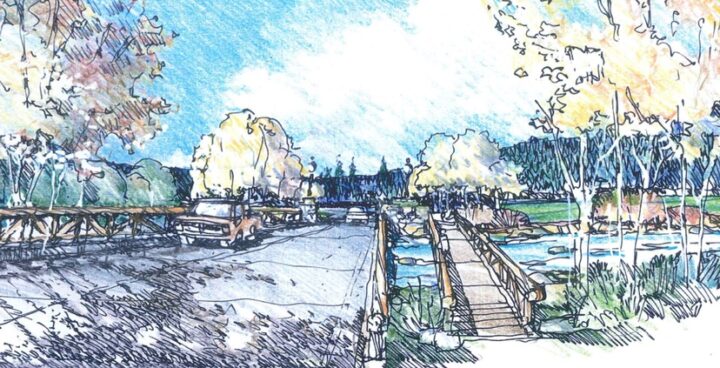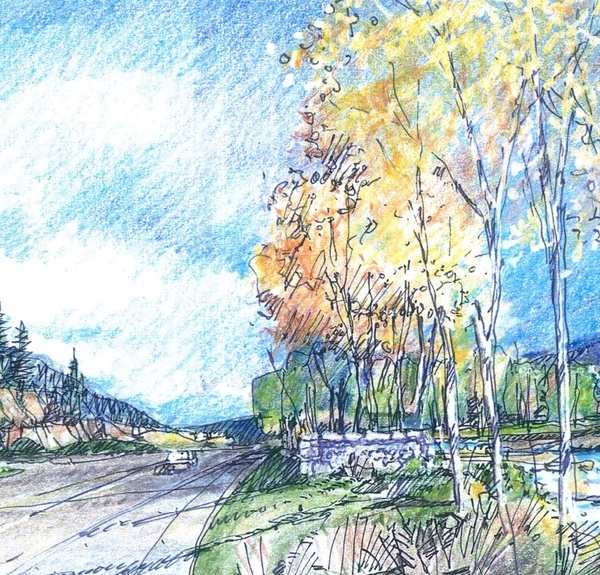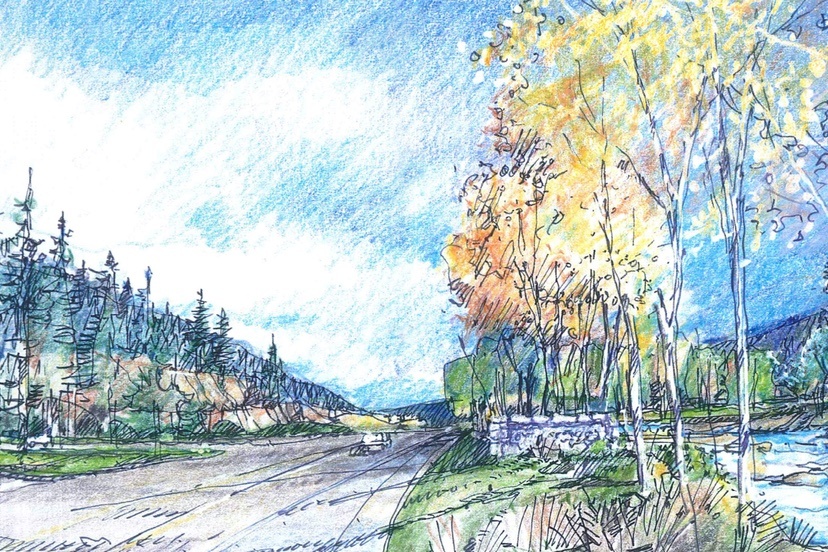Given the inevitability of growth, the Mayor’s Council seeks to encourage a healthy economy while sustaining the unspoiled natural environment of the region and a vibrant diverse community…
— from the ‘Renewed Historic Downtown Pagosa Springs: Conceptual Master Plan’, November 2004.
The Town of Pagosa Springs has hired a new Town Manager, David Harris, to steer the municipal ship into a foggy sea, full of dangerous icebergs.
Some of the icebergs are behind us.
My very first article for the Daily Post, back in December 2004, summarized some of my thoughts and experiences at a well-attended public event, jointly hosted by the Town of Pagosa Springs, developer David Brown, and the Community Vision Council.
The social event was held in the newly-built Pagosa Springs Community Center (now the Ross Aragon Community Center) and featured colorful conceptual drawings showing how Mr. Brown and his supporters hoped to rebuild downtown Pagosa Springs from a struggling commercial area into a world-class tourism hub. But with a “small-town” feel.
This would be a “renewed” historic downtown, made to feel like the commercial area at the entrance to a National Park.

Mr. Brown, a billionaire from California, had been one of the key players in the creation of what we now refer to as Silicon Valley, in a location that was — prior to the arrival of David and his fellow developers — a vast agricultural landscape in the Santa Clara Valley. The orchards and farms in the area had been producing a traditionally-low-profit social benefit — food — and were replaced by office building for exceptionally-high-profit tech industries, originally supported by the US military but gradually branching out into other types of ‘social benefits’ like information (Google, Oracle, Cisco); computers and communications (Apple, Intel, HP); entertainment (YouTube, Netflix, Nvidia); work and finance (Salesforce, Intuit, PayPal); transportation (Tesla, Uber, Lyft)… and so on.
David and his family had purchased the 3,200-acre Bootjack Ranch, just over the Archuleta County line in Mineral County, and David felt he could help the Pagosa community become more prosperous by selling some development concepts to business and political leaders. He also purchased several downtown properties that didn’t fit his ideas about Pagosa’s future, and he demolished the buildings, to help make way for a ‘better’ downtown.
Here, you can download the Renewed Historic Downtown Pagosa Springs, Conceptual Master Plan, produced in November 2004 for Mr. Brown’s invitation-only Community Vision Council.
Chapter 1: A Conceptual Plan (32MB)
Chapter 2: Early Projects (9MB)
Chapter 3: Suggested Plan of Action (2MB)

David’s sales pitch was embraced by a segment of the community. Many long-time Pagosa residents, however, found the idea of a California billionaire remaking their historical downtown to fit his own concepts, to be offensive. As did some relative newcomers, like myself.
The vacant lots created by Mr. Brown still sit vacant, 19 years later. He passed away in 2013, without seeing his vision accepted by the community.
But a few of the concepts developed by the urban planners at California-based Hart Howerton have since been achieved. The reconstruction of the 400 block of Lewis Street, for one. The creation of Yamaguchi Park, for another. Additional footbridges across the San Juan River, and extension of the River Walk.
While researching this editorial, I noticed — in a drawing of the conceptual east entrance to downtown drawn by the Hart Howerton architects — a rough indication of a “Welcome to Pagosa” monument sign…

…which looks suspiciously similar to the monument sign constructed by the Town government several years later, in that very spot.
One thing missing from Mr. Brown’s Conceptual Master Plan — which presumably went unnoticed by the business and political leaders supporting the plan in 2004 — was any mention of the word, “housing”.
Many of the business and political leaders who supported Mr. Brown’s efforts have since retired or passed away, and a new generation of business people and government officials have stepped up to fill their shoes. A general attitude around wanting Pagosa Springs to become a tourism mecca, however, remains.
As for the workers who stock the shelves, fix the broken pipes, change the motel linens, plow the snow, handle the bookkeeping, teach the children, and haul the trash… many of them have also retired or passed away. But finding younger people to fill their shoes becomes harder and harder with each passing year.
When you’re helping direct a community’s development, it’s so much easier to keep doing the same thing, over and over, than to change direction.
So often, it takes a crisis to make you change direction. But then, later, it’s easy to fall back into the same old patterns.
Although David Brown did not live to see his vision achieved, his general idea — that we will thrive as a community if we make ourselves as attractive as possible to visitors and second home buyers — continues to be embraced by many of our local business and government leaders.
On November 7, the Pagosa Springs Town Council approved an Intergovernmental Agreement (IGA) with Archuleta County.
Intergovernmental Agreement Between Archuleta County and the Town of Pagosa Springs
Regarding the administration of the Pagosa Springs Area Tourism Board and administration of Lodging Tax funding in a cooperative effort to promote Pagosa Springs and Archuleta County as a Tourism Destination
I’ve written often about the impacts of tourism on the Pagosa Springs economy. As an observer of tourism growth over a 30-year period, I’ve come to the conclusion that the tourist economy has greatly benefited a select few, and has been essentially detrimental for the majority of Pagosa Springs residents.
Not many of our local leaders agree with that assessment.
The Town-County IGA includes this statement:
2.1.5 Capital Expenditure projects may be considered by the Tourism Board, if they are tourism related in that the project will improve the experience of the visitor; however, only the Town’s Lodging Tax revenue may be used for such projects as the County’s Lodging Tax is restricted by C.R.S. § 30-11-107.5 to only the marketing and advertising of local tourism.
We will explore the meaning of that statement more closely in this editorial series.

